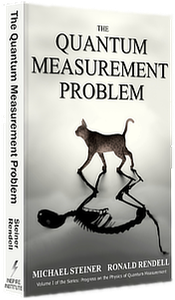THE QUANTUM MEASUREMENT PROBLEM
Available at Amazon.com
“... Steiner and Rendell present a detailed mathematical argument that the Schrödinger equation on its own cannot normally lead to an outcome that resembles a random measurement event...its conclusion is quite important since some eminent physicists, such as Feynman, seem to have believed otherwise...The most important chapter of the book is devoted to a thorough and extensive survey of all the approaches to the measurement problem...These are all presented, discussed and evaluated in a very extensive collection that is more complete than in many other works on the subject...The historical discussion is very readable and informative in its own right, and of great value to have. It includes quite a lot of material that I had not encountered before…This book is idiosyncratic but full of information, and its treatment of the quantum physics is in my opinion comprehensive, sound and reasonable...It is a book, then, that will be helpful to open-minded experts in the field, on the whole, and for those who seek to embark on further research in this area."
Peter J. Bussey, Book Review: The quantum measurement problem, Contemporary Physics (2018)

Executive Summary
The Quantum Measurement Problem (QMP) is a single resource for information on the QMP and it establishes a basis for research on what is arguably the most well-known and still-unresolved scientific problem: how does our observed world relate to the quantum? The book is suitable for both undergraduate level study on a selective basis as well as graduate level study and for use as a resource for research scientists interested in aspects of the QMP. There are many sections that can even be profitably read by the general public to appreciate the history and future importance of the QMP. Although many books are now available that adequately address Quantum Information, this is the first book offering a comparable treatment for the QMP.
There are some in the physics community that view the QMP only as a problem that requires an interpretation while others view its solution as essential to complete our physical description of the world and enhance our ability to design experimental probes of its physical elements in terms of quantum physics. This book critically examines these two viewpoints and resolves this dichotomy in favor of the latter viewpoint. The problem is precisely defined in terms of experimental operations and the scientific requirements that a resolution would have to meet. It explains why the QMP is a physical problem that requires more than an interpretation for its resolution and why a solution could have profound implications for physics as well as other fields. In particular, it uses quantum information methods for a constructive demonstration that unitary Schrödinger processes can be experimentally distinguished from measurement processes using well-established techniques such as Bell measurements, which would establish that measurement is a non-unitary process. Neither Schrödinger’s equation nor the measurement postulate is found to be sufficient to explain measurement. For the first time, The QMP offers a single resource that thoroughly assesses the strengths and weaknesses of the major approaches to the QMP along with the historical and scientific background to understand its context.
The importance of the QMP is due to the fundamental questions it asks. How does the reality of the observed properties of the world around us relate to the quantum domain? Are we restricted in our choices of which properties can be observed? To what extent can the elements of reality be established independently of us? Can the development of events be described in a deterministic manner or does indeterminism play an essential role? By the first decades of the 21st century, these questions have increasingly been impacted by a proliferation of experimental developments which can address the foundations of quantum physics, finally putting us in a position to resolve the QMP.
The exposition in The QMP contains eight chapters, including problem sets, with dual tracks throughout the book that allow both those with a technical background in quantum physics or quantum information as well as less-technical readers to come up to speed on the QMP, depending on their interests and background.
- Chapters 1 and 2 are an introductory-level presentation of wave-particle duality and unitary Schrödinger processes.
- Chapter 3 is a key chapter that uses quantum information methods for a constructive demonstration that unitary Schrödinger processes can be experimentally distinguished from measurement processes using well-established techniques such as Bell measurements, which would establish that measurement is a non-unitary process.
- Chapter 4 presents a detailed definition of the QMP in terms of experimental observations and uses the results of Chapter 3 to systematically evaluate the strength and weaknesses of all the major approaches to the QMP in the literature and determine which constitute physical theories as opposed to philosophical interpretations.
- Chapter 5 gives an uncensored historical perspective leading to the development of quantum physics from the viewpoint of those physical aspects which will ultimately form the elements of the QMP.
- Chapter 6 presents a unique discussion of the Scientific Method and how the use of scientific deduction within the approach of radical conservatism can most proficiently address problems of quantum foundations.
- Chapter 7 presents concepts and mathematical tools useful for further research developments of both closed and open system approaches to the QMP.
- Chapter 8 presents conclusions and the status of the QMP for moving forward.

